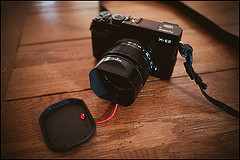Portrait Photography with Fuji XE-2
/ This is my standard portrait set up and I use aperture priority in conjunction with auto ISO.
This is my standard portrait set up and I use aperture priority in conjunction with auto ISO.
Here are my settings:
ISO set to 200 Auto on ~ max 3200 with a minimum shutter speed set for each lens as follows: 14mm ~ 1/40th second, 23mm ~ 1/100th second, 35mm ~ 1/160th second Shutter speed dial set to A Aperture dial set to f/1.4 – f/4 as required Jpeg Fine + Raw Auto WB Ns film simulation, occasionally Astia Soft
AF set to S Activated on a half press of the shutter. I then move the focus zone around the frame as needed. I set the focus zone as the smallest square available as any background detail within the square during focusing might cause the lens to back focus.
With these settings dialed in I just pick up the camera, switch it on and start shooting. I adjust the shooting the exposure compensation as required via the very convenient dial, I change the focus zone to the best position for each shot and I reset the minimum shutter speed for Auto ISO in the ISO menu (Fn button) if I change my lens.
With the AF set to activate on a half shutter press I have to focus before every exposure. I rarely shoot multiple frames the same so I really don’t mind doing this.
I set the aperture and let the camera adjust the ISO from 200 to 3200 to suit the light level. When it runs out of ISO range it alters the shutter speed. I came to the values of minimum shutter speed using my simple formula* (See the section on shutter speed below). Occasionally I’ll dial in a higher shutter speed, especially when using the 14mm lens if the subject movement demands it. I just set the shutter speed dial to the value I want and the auto ISO continues to perform just as before.









